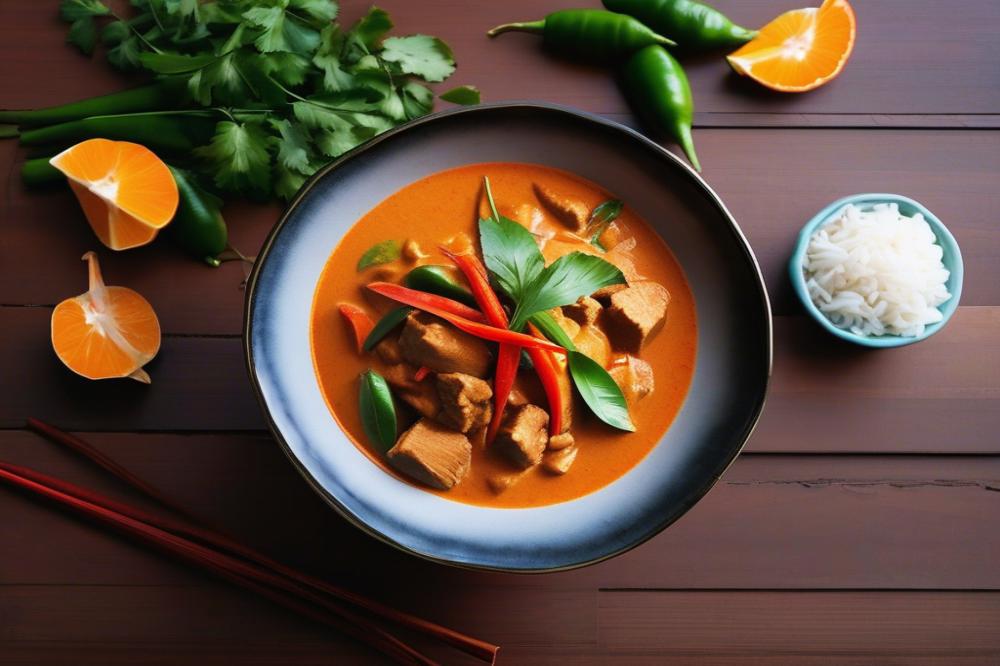Introduction
Panang Curry is a rich and flavorful dish that showcases the vibrant elements of Thai cuisine. With its creamy texture and complex flavors, this curry is made special by the use of aromatic ingredients like coconut milk and red curry paste. Thai cooking offers a wonderful balance of spices and freshness, making it a favorite for many. The importance of this culinary tradition can be seen in the diverse array of dishes it produces, appealing to lovers of spicy food and innovative flavors.
Creating a homemade curry recipe can be satisfying and rewarding. A well-cooked meal brings joy and a sense of accomplishment. Using Pork in this dish enhances its richness, giving it a hearty feel. Cooking tips are often shared among families, passing down these cherished recipes over generations. As you prepare this curry, you will find that the process is not just about feeding yourself, but also about experiencing the culture and heritage of Asian dishes.
The appeal of making your own curry can be attributed to the ability to control flavors and adjust spice levels. While many may prefer the convenience of takeout, cooking at home allows for personalization. Each ingredient you add, from fresh herbs to the choice of meat, contributes to the overall outcome. Homemade curry offers a deeper connection to the food we enjoy, making it a perfect choice for a family meal or a cozy dinner.
Understanding Panang Curry
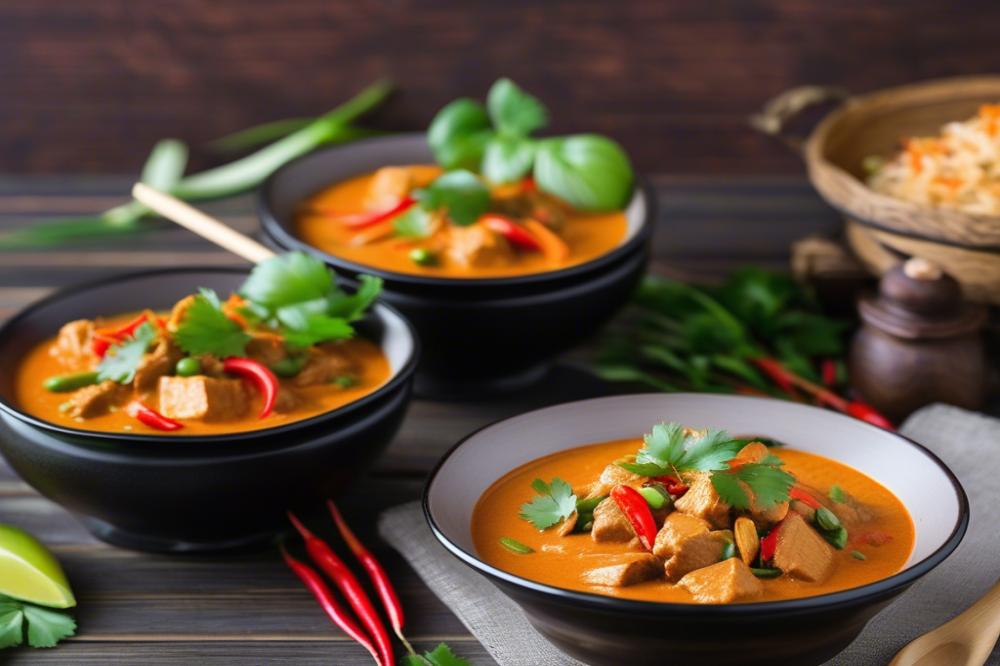
Definition and Origin of Panang Curry
Panang curry is a rich and flavorful dish in Thai cuisine. This type of curry comes from Malaysia and is named after the island of Penang. It has its roots in traditional Thai cooking with a unique twist that makes it special. While many curry recipes exist, Panang stands out for its creamy texture and depth of flavor.
Differences Between Panang and Other Thai Curries
Comparing Panang to other Thai curries reveals distinct differences. For instance, red curry paste is the foundation for many varieties, while Panang typically uses a thicker, sweeter blend. Other curries may contain more water or broth, making them lighter. A key feature of this dish is the inclusion of coconut milk, which adds creaminess. In addition, the choice of protein, such as Pork, can enhance the overall taste. Spicy food enthusiasts will find Panang less fiery than green curry, due to its focus on sweet and savory elements.
Characteristics of Flavors and Ingredients
Flavors of Panang curry are balanced and complex. The sweetness of coconut milk pairs well with the spices in the red curry paste. You will also notice hints of kaffir lime leaves, which contribute a citrusy note. Peanuts play an important role too, adding texture and richness. Fresh herbs, like basil, are often used as a garnish to elevate the taste. Cooking tips suggest using high-quality ingredients for the best result. Using homemade curry paste can significantly enhance the flavors, making a noticeable difference. This dish showcases the best of Asian dishes, proving that a simple pork recipe can deliver great flavor.
Ingredients and Cooking Instructions
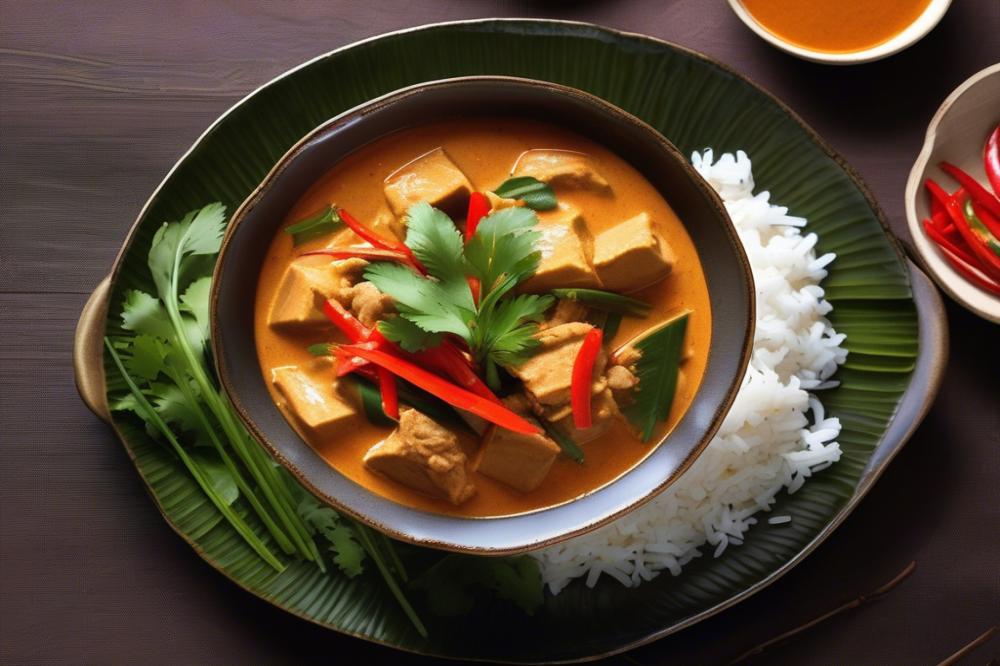
Ingredients for Panang Curry with Pork
- Pork (500g)
- Red curry paste (3 tablespoons)
- Coconut milk (400ml)
- Fish sauce (2 tablespoons)
- Palm sugar (1 tablespoon)
- Kaffir lime leaves (3)
- Fresh basil leaves (for garnish)
- Vegetables (optional: bell peppers, carrots)
Cooking Instructions
Start your culinary adventure by cutting the pork into thin slices. This helps it to cook evenly. In a large skillet, heat a bit of oil over medium heat. When hot, add the red curry paste, stirring constantly. You want to fry the paste for about two minutes until it becomes fragrant.
Next, pour in the coconut milk slowly. Stir the mixture well to combine. It should start to look creamy. Once it’s blended, add the sliced pork. Cook this for about 10 to 15 minutes until the meat is tender. If you’re including vegetables, toss them in when the pork is almost done.
Add fish sauce and palm sugar to the mix. These ingredients enhance the flavor, making it a delightful experience for your taste buds. Don’t forget to tear the kaffir lime leaves and toss them into the curry. Let everything simmer for a few minutes.
Once the dish is ready, it’s time to serve. Spoon the curry into bowls and top with fresh basil leaves. Pair it with jasmine rice for a complete meal. Enjoy your homemade curry!
Nutritional Information
Understanding the nutritional value of each ingredient can help tailor your meal. Here’s a breakdown:
- Pork (500g): Approximately 1,200 calories, 90g fat, 90g protein
- Red curry paste (3 tablespoons): Approximately 80 calories, 4g fat, 2g protein
- Coconut milk (400ml): Approximately 700 calories, 72g fat, 5g protein
- Fish sauce (2 tablespoons): Approximately 20 calories, 0g fat, 2g protein
- Palm sugar (1 tablespoon): Approximately 60 calories, 0g fat, 0g protein
- Kaffir lime leaves: Negligible calories
- Fresh basil leaves: Negligible calories
- Vegetables (bell peppers, carrots): About 50 calories for 100g total
Cooking Tips for Perfect Panang Curry
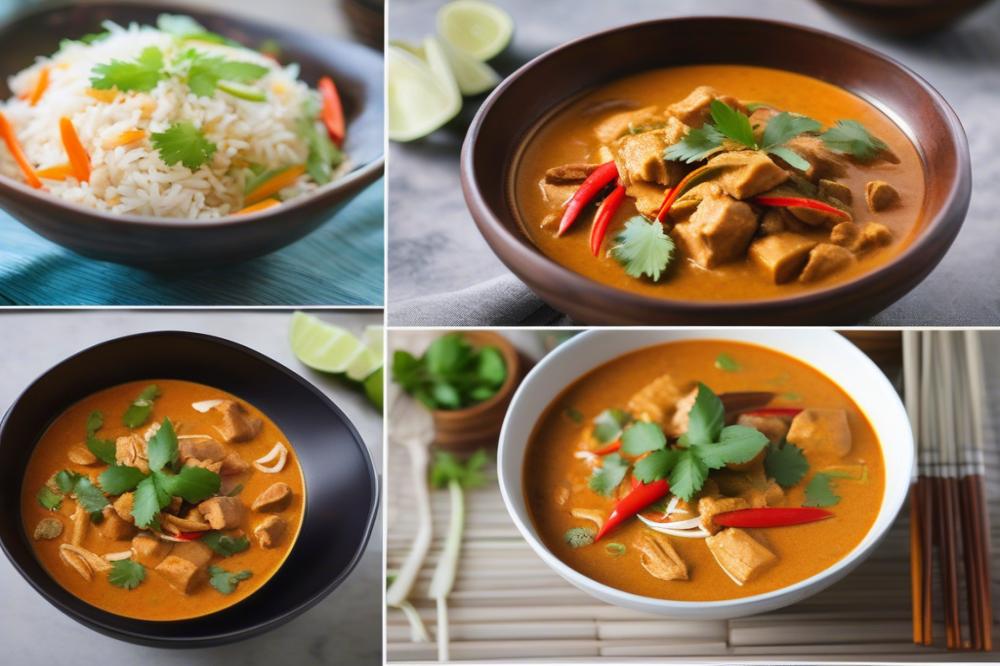
Choosing the Right Pork Cut
Selecting the right cut of pork is essential for a flavorful dish. Pork shoulder or tenderloin works well for this curry recipe. Both cuts are tender and absorb the flavors beautifully. Avoid lean cuts like pork chops, as they may dry out during the cooking process. Marbling is important because it adds to the dish’s richness and depth.
Adjusting Spice Levels for Your Taste
Thai cuisine often presents a bold array of flavors, and the heat can be adjusted to suit your preference. Start with a small amount of red curry paste, then gradually add more until you achieve the desired level of spiciness. For those who enjoy less heat, consider using a milder variety of curry paste. Balancing out the spice with coconut milk helps create a creamy and fragrant sauce that melds beautifully with the meat.
Importance of Using Fresh Ingredients
Fresh ingredients significantly enhance the overall taste of your homemade curry. Whenever possible, opt for fresh herbs like basil or cilantro. Fresh vegetables, such as bell peppers and green beans, add texture and color to the dish. Even the quality of coconut milk can make a difference. High-quality coconut milk will have a richer flavor and a creamier consistency, which elevates the dish.
Tips for Serving and Pairing with Rice
When it comes to serving, jasmine rice is a classic choice for pairing with Asian dishes. Steaming the rice will provide a fluffy texture and soak up the curry’s flavors. For a twist, consider serving the dish with brown rice or even quinoa for a healthier option. Garnishing with fresh herbs, like lime leaves or additional basil, not only enhances presentation but also adds a refreshing note to each bite. Don’t forget to offer extra lime slices on the side, as they add a wonderful contrast to the richness of the curry.
Exploring Variations of Panang Curry
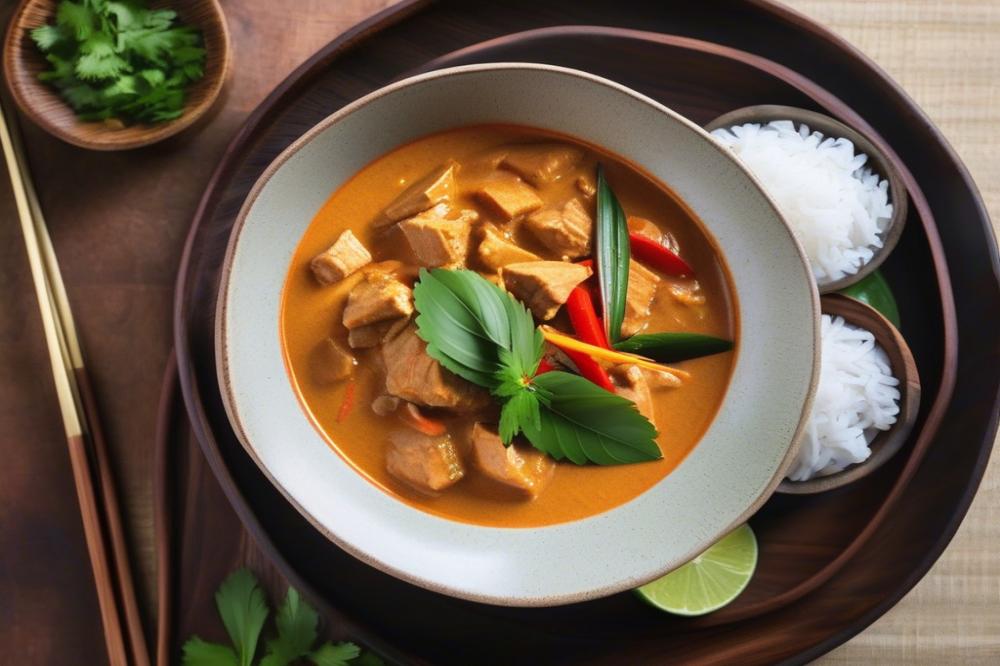
Many people enjoy the rich flavors of Panang curry, but there are numerous ways to customize this dish. Different proteins can be used to create unique and satisfying meals. Chicken, beef, or even tofu can serve as alternatives to pork. Each option adds its own texture and flavor to the dish.
Switching to vegetarian or vegan adaptations is simple with this curry recipe. By replacing meat with vegetables or legumes, you can still enjoy a delicious meal. Coconut milk and red curry paste remain essential for achieving that signature taste. Adding tofu or chickpeas enriches the texture while keeping it plant-based.
Incorporating seasonal vegetables is another way to enhance your homemade curry. Fresh ingredients such as bell peppers, carrots, or green beans bring color and nutrition. Use what’s available in your area for the best flavor. This approach also allows for creativity. Think outside the box and mix different vegetables to find a combination you love.
When it comes to side dishes, several options complement this flavorful Thai dish. Steamed jasmine rice is a classic choice. It absorbs the sauce beautifully and balances the spicy food. For something different, consider serving it with rice noodles or quinoa. Salads can add a refreshing crunch; consider a simple cucumber salad or a spicy green papaya salad.
The Cultural Significance of Panang Curry
Curry holds a special place in Thai culture. It is not just food; it represents a way of life. People often gather around the dining table to share meals, creating bonds over flavorful dishes. These meals often feature rice, fresh vegetables, and, of course, curries. They offer a rich tapestry of tastes and textures, showcasing the balance that is essential in Thai cuisine.
Traditional Thai cooking greatly influences modern recipes, including many homemade curry options. Chefs and home cooks alike often refer back to age-old techniques while adding their personal twists. Cooking tips passed down through generations help maintain the essence of authentic dishes, like those made with pork. These adaptations make it easier for anyone to recreate the warm, comforting essence of a curry recipe right in their kitchen.
Experiencing Thai curry is about more than just the taste. It invites people to connect, explore, and understand the rich heritage behind every dish. Enthusiastic cooks often seek to share these flavors, which helps keep cultural traditions alive. Through cooking, individuals can share a piece of Thailand‘s heart and soul, whether they’re making a simple curry or a complex feast.
Wrapping Up Your Culinary Adventure
Recapping the process of making Panang Curry with Pork reveals its delightful simplicity. Starting with fresh ingredients and vibrant flavors can create a remarkable dish. Choosing the right cut of pork is essential for achieving that tender texture. Crafting the curry paste from scratch, if you opted to do so, really enhances the meal. Cooking at a steady pace lets those rich flavors meld beautifully. Allowing the dish to simmer draws out the best in every component. The result is a meal that warms the soul and excites the palate.
Making homemade curry is a rewarding experience. What better way to share a meal than by inviting friends or family to taste your efforts? This curry recipe can become a staple in your kitchen. Everyone enjoys mining the depths of spicy food, and creating a Thai dish brings the essence of that cuisine right to your table. Trying various spice levels lets you explore what suits your taste buds best.
Ultimately, delighting in flavorful and spicy dishes opens a door to new culinary experiences. Cooking at home means you can adjust ingredients to match your preferences. Finding joy in creating something so savory is truly fulfilling. Get creative and enjoy the process! Thai cuisine has much to offer, and there is always more to learn. Dive into your ingredients, and let each meal inspire you to explore further.

